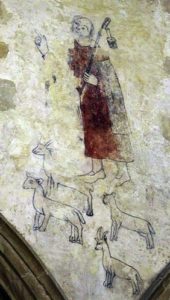From the outside, there is nothing special about the church, it could be any church, anywhere in England. It is set in a large churchyard on the edge of the village. It has a square battlemented tower with a decorative frieze around the top and large gargoyles at the corners. There is a very tall nave with lower side aisles and chancel and large south porch with a priests room above.
The original church was 12thC. Side aisles were added in the 14thC and clerestory in the 15thC. The chancel was rebuilt in the 19thC. From the outside, it is a rather ordinary English parish. Its main claim to fame are the wall paintings inside which are some of the most extensive in the country.
One of the great things of visiting churches is that you never know what you will find inside and we were bowled over by the quality and quantity of the wall paintings.
Stepping down through the old wooden door into the nave, past the old wooden strong box, the eyes are immediately drawn to the north wall with its paintings. The earliest date from the 14thC but some have been painted over in the 15thC.
On the west end of the north wall of the side aisle is a painting of (a headless) St Michael weighing souls in a balance. To the right are a double row of heads sheltering under the cloak of a now gone Mary. Next to it is a lovely outline of St Anne teaching the Virgin Mary to read. Beyond is St Christopher carrying the Christ Child wearing a tunic with blue spots. The top is partially covered by a later seven deadly sins and a Pieta of Mary with the dead body of Christ.
Above the arches of the north clerestory are images of two of the Magi with a nativity scene with a crowned and haloed Virgin, holding the Christ Child. At her feet to the right is a smaller image of Joseph in a hat with an ox.
On the clerestory to the south is the seated figure of Herod holding a sword. To the west are two paintings of shepherds with sheep. Above the chancel arch is the Last Judgement but details are difficult to make out. There are more indistinct paintings round the window at the east end of the south aisle and an inscription above the south door.
There are tall pillars with pointed arches separating nave and side aisles. A pointed arch leads into the chancel. There is a wood beam roof with carved faces on the corbels supporting the beams. The font by the north door is probably 14thC. Above the tower arch is the Royal Coat of Arms. The wooden pulpit has a carving of St John the Evangelist on the front panel. Above is the small wooden door which would have lead out onto a long gone rood loft.
The chancel is very simple with an altar under the 19thC stained glass window At the top is a dove with four angels below. The three main images show Jesus the Good Shepherd, ‘Suffer little children to come unto me” and Christ carrying his cross. The window on the south wall has Faith, Charity and Hope above two resurrection scenes.
There are traces of 15thC glass in a window on the north wall including a lovely fragment f the head of the Virgin. In a small round quadrifoil window at the back of the north aisle is a 15th image of St John the Evangelist.
There are some splendid memorials in the church including a splendid one to Frances Wilcox who died in 1764 complete with Latin eulogy.
This is a nice little church and the wall paintings are exceptional. It is a pity it isn’t better known. If driving the A1 it is definitely worth making the detour to find it. The church is open from 10am to dusk. We parked by the Church Street Rooms by the post box.
The Pantry in the Market Place is recommended for a light lunch and its home made cakes.










